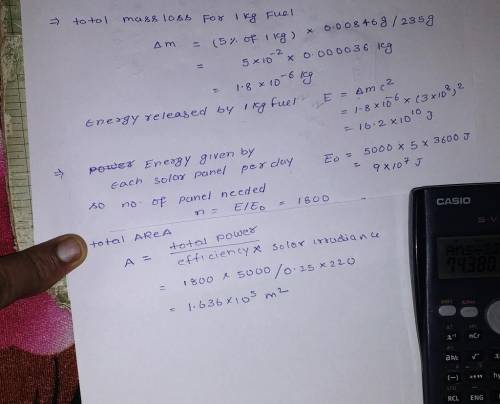
Physics, 20.03.2020 04:35 jessnolonger
You are conducting preliminary research for an energy company and your job is to compare nuclear energy and solar energy. You need to calculate how many solar panels will be needed (and the total area they will occupy) to substitute 1 kg of nuclear fuel. Here is what you know so far: when 235 g of pure uranium reacts in a nuclear reactor, the mass loss is 0.00846 g. 1 kg of nuclear fuel contains 5% pure U-235. Each solar panel produces 5000W, the solar irradiance in the region is 220 W/m2 with an availability of 5 hr per day, and the efficiency of the solar panels is 25%.

Answers: 1


Another question on Physics

Physics, 22.06.2019 04:40
How is the gravitational force related to the distance between two objects?
Answers: 1

Physics, 22.06.2019 05:40
Karen is running forward at a speed of 9 m/s. she tosses her sweaty headband backward at a speed of 20 m/s. the speed of the headband, to the nearest whole number relative to a stationary observer watching karen
Answers: 1

Physics, 22.06.2019 13:10
The atoms in a nickel crystal vibrate as harmonic oscillators with an angular frequency of 2.3 × 1013 rad/s. the mass of a nickel atom is 9.75 × 10-26 kg. what is the difference in energy between adjacent vibrational energy levels of nickel? (h = 6.626 × 10-34 j • s, , 1 ev = 1.60 × 10-19 j)
Answers: 2

Physics, 22.06.2019 21:50
Determine the moment of the force f about an axis extending between a and c. express the result as a cartesian vector. a is at the origin, c is at (4,3,0) and f = (4i + 12j -3k) lb coming out of b (4,3,-2).
Answers: 2
You know the right answer?
You are conducting preliminary research for an energy company and your job is to compare nuclear ene...
Questions

Mathematics, 05.10.2020 02:01


English, 05.10.2020 02:01

Mathematics, 05.10.2020 02:01






Mathematics, 05.10.2020 02:01

Mathematics, 05.10.2020 02:01

Mathematics, 05.10.2020 02:01

Mathematics, 05.10.2020 02:01

Mathematics, 05.10.2020 02:01

Mathematics, 05.10.2020 02:01




Mathematics, 05.10.2020 02:01




